Let’s learn how to deploy Bitwarden Password Manager using Intune. Bitwarden is the password manager; it can easily generate, store, and secure unique usernames and passwords.
Bitwarden is a Password manager worth using, and it includes strong encryption, two-factor authentication (2FA), password security auditing, password breach monitoring, and cloud or local hosting options. You can easily access Bitwarden by entering a master password.
Bitwarden is the best option to protect all your Passwords and quickly fix any security issues. Bitwarden is a free/freemium open-source password management solution for individuals, teams, and business organizations.
The biometric login feature is available for Bitwarden on Android, iOS, macOS, and Windows operating systems. When you enable the biometric login in Bitwarden, you eliminate the need to type the passwords every time.
You can easily download the Bitwarden Application from the Bitwarden official site. Bitwarden offers various installation options for the desktop application, and here you need to download the windows based setup of the Bitwarden Application.
- Deploy Windows Update Offline Using Intune
- Override Intune GRS: Trigger IME to retry failed Win32 App Deployment
Prepare INTUNEWIN Win32 App
Before adding a Win32 app to Microsoft Intune, you must prepare the app using the Microsoft Win32 Content Prep Tool. You use the Microsoft Win32 Content Prep Tool to pre-process Windows classic (Win32) apps.
Let’s first identify the command line to perform the silent installation or uninstallation of Bitwarden Password Manager.
- Installation Command
- Uninstallation Command
- Detection Method
Important – I would recommend performing manual testing to ensure scripts are properly executed before converting and uploading files in Intune.
| Install Command | Uninstall Command |
|---|---|
| Bitwarden-Installer-2022.9.1.exe /allusers /S | Bitwarden-Installer-2022.9.1.exe /uninstall /allusers /S |
Download the updated IntuneWinAppUtil.exe from GitHub. Run IntuneWinAppUtil.exe file Run as administrator.
- Please specify the source folder – Enter the folder that contains your application setup files. (For Example, C:\Users\JiteshKumar\Downloads\Source)
- Please specify the setup file – Enter the setup file name (such as setup.exe or setup.msi), For Example – Bitwarden-Installer-2022.9.1.exe
- Specify the output folder – Add the output folder for the generated .intunewin file.
- Do you want to specify catalog folder – Type N.
Note – Please wait a few minutes while running the Win32 Content Prep Tool. Once it generates the .intunewin file, the status indicates 100% at the bottom of the command prompt.

Once the process completes, Browse to the output folder (For Example, C:\Users\JiteshKumar\Downloads\Output) to collect the Intune Win32 app deployment file.
- Best Guide for Bitwarden Password Manager | Detailed Review
- Bitwarden Deployment Using SCCM | Deploy EXE File
Deploy Bitwarden Password Manager using Intune | Endpoint Manager
Let’s follow the steps below to upload the Bitwarden Password Manager executable file for deploying to managed devices.
- Sign in to the Microsoft Endpoint Manager admin center https://endpoint.microsoft.com/ with appropriate access rights.
- Select Apps > All apps > Add, or you can navigate to Apps > Windows > Windows Apps.
- On the Select app type pane, select Windows app (Win32) under the Other app types and click Select.
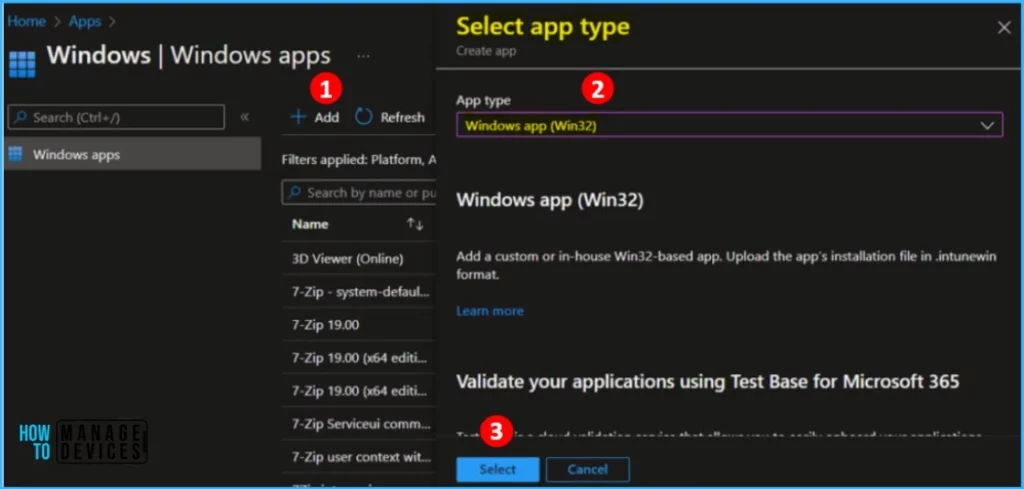
On the Add app pane, click Select app package file. Select the browse button. Then, select the prepared file with the extension .intunewin. The app details appear. When you’re finished, select OK on the App package file pane.
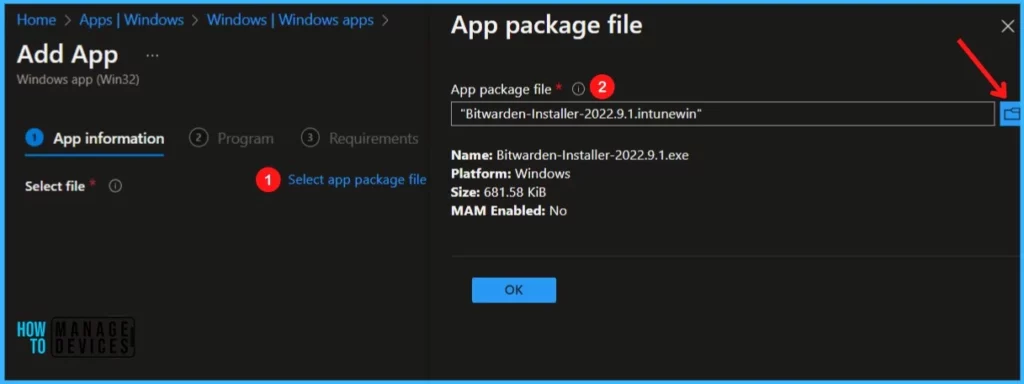
Enter the Name of the Windows App Win32 (For Example – Bitwarden Password Manager), and Enter the Description of the Windows App.
Enter the Publisher name – Bitwarden Inc, and You may specify the additional app information here. Upload an icon for the app. This icon is displayed with the app when users browse the company portal and click Next.
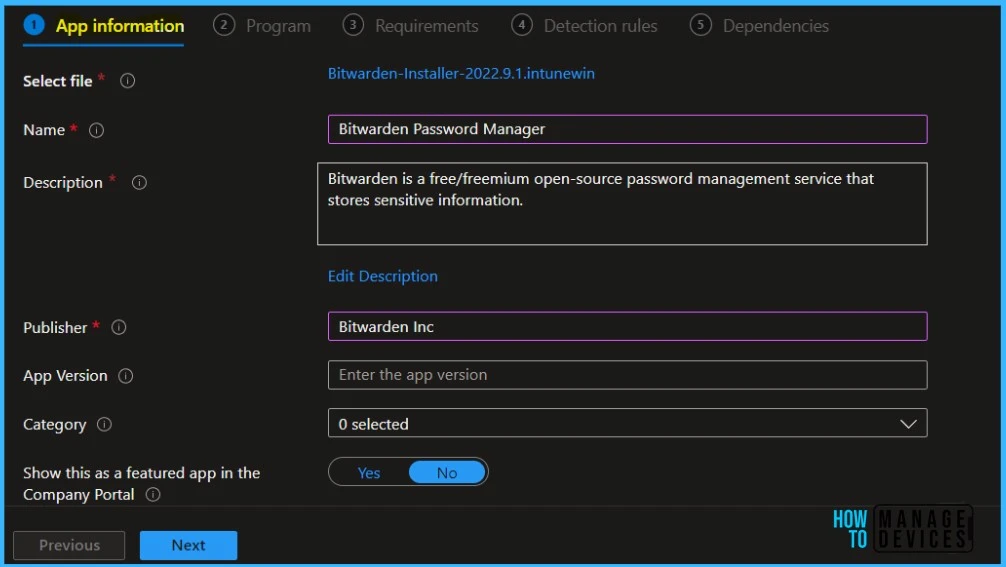
The most important part is to specify the commands. On the Program, configure the app installation and removal commands for the app:
- Install base: Add the complete installation command line to silent install Bitwarden Password Manager.
- Uninstall command: Add the complete command line to uninstall Bitwarden Password Manager.
- Install behavior: Set the install behavior to System.
You can also specify the Device restart behavior and Post-installation behavior. Click Next to continue.
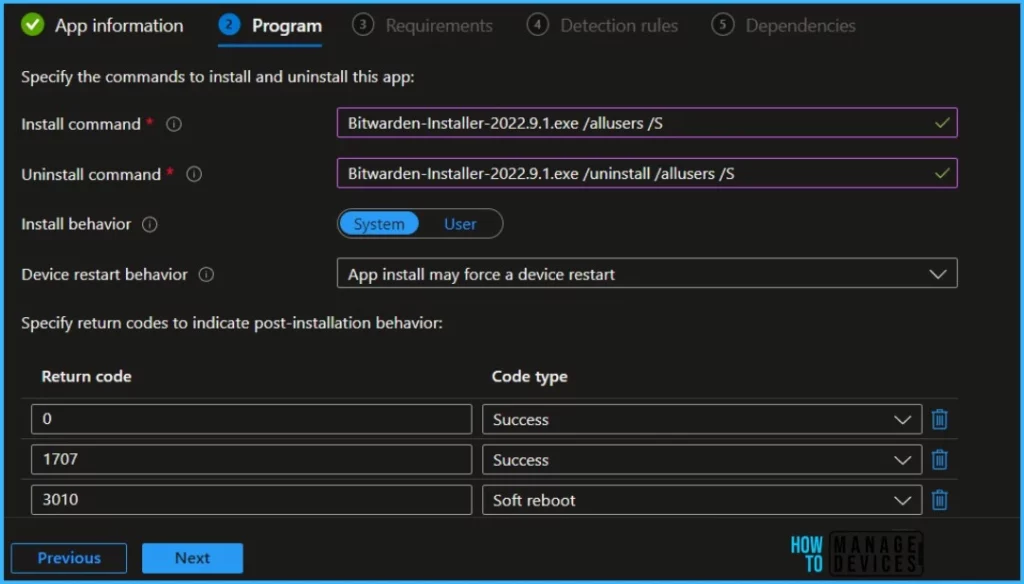
On the Requirements page, specify the mandatory requirements that devices must meet before installing the update and click Next.
- Operating system architecture: Choose the architectures needed to install the Bitwarden.
- Minimum operating system: Select the minimum operating system.
There are some built-in and custom requirements rules when creating your Win32 application. Explore Intune Win32 App Requirement Rules.
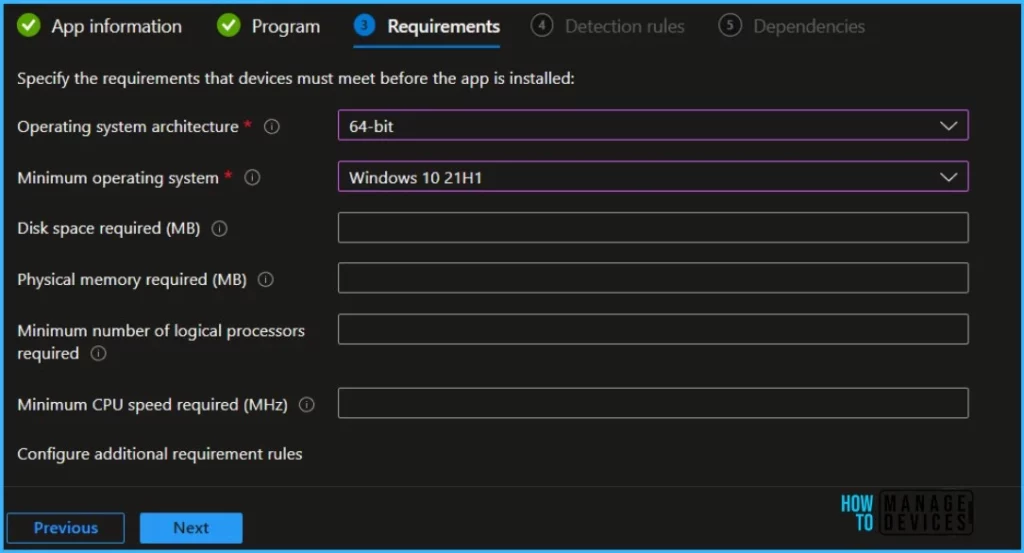
On the Detection rules pane, configure the rules to detect the presence of the app. You can choose to add multiple rules.
Here I selected the Manually configure detection rules format. Click on Add button, and A popup will appear showing the Detection rule. This detection rule format provides three detection rules MSI, File, and Registry.
Here you can check the registry path for the applications. Most apps are installed in the same location depending on the app architecture – Detection Method for Intune Win32 App. For Example, Here, Check for registry value string equals.
Computer\HKEY_LOCAL_MACHINE\SOFTWARE\Microsoft\Windows\CurrentVersion\Uninstall\173a9bac-6f0d-50c4-8202-4744c69d091a DisplayVersion = 2022.9.1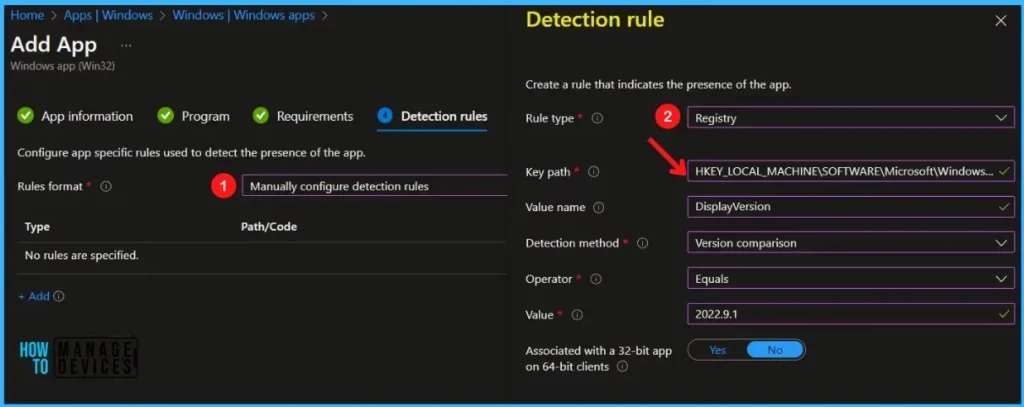
You can also specify app dependencies where the applications must be installed before your Win32 app can be installed.
In the scope tag section, you shall get an option to Configure scope tags for this Windows App Win32 application.
Under Assignments, In Included groups, click Add groups and then choose Select groups to include one or more groups to which you want to deploy the Windows Update. Click Next to continue.
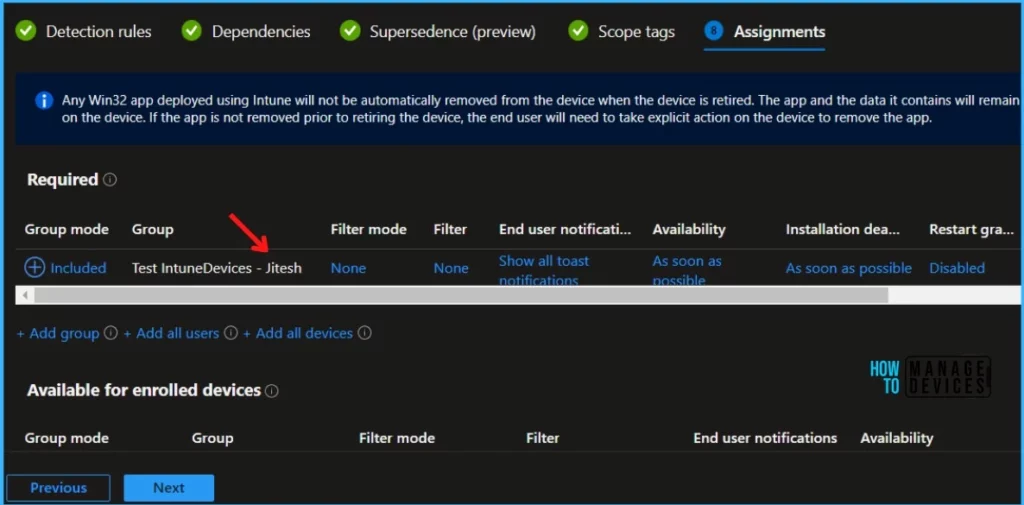
Review your settings and select Create to add the app to Intune.
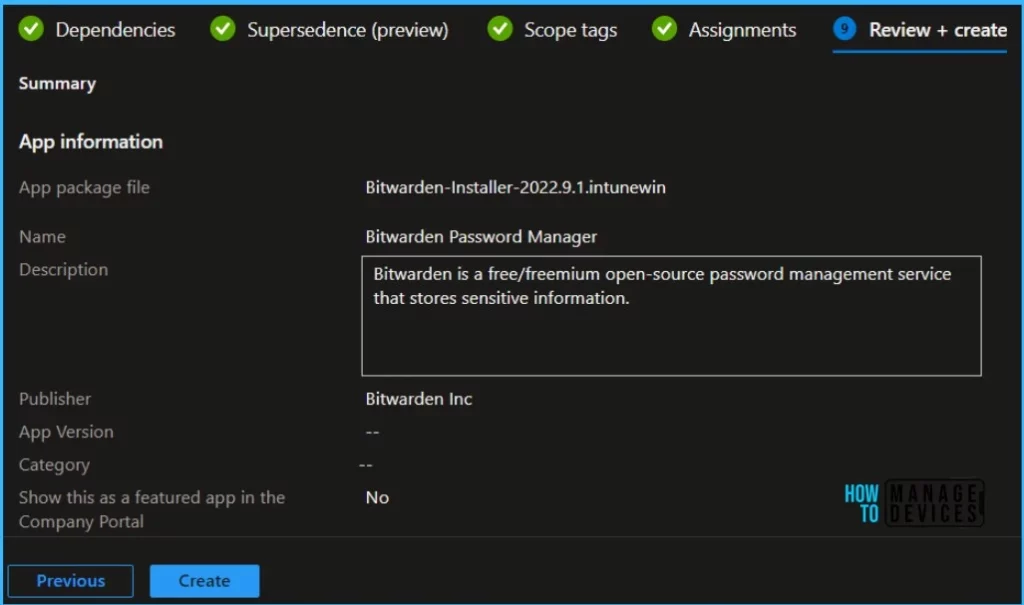
Here you can see the status Uploading is in progress – How much time will it take to complete the upload? It depends on the size of the application and the speed of internet connectivity.
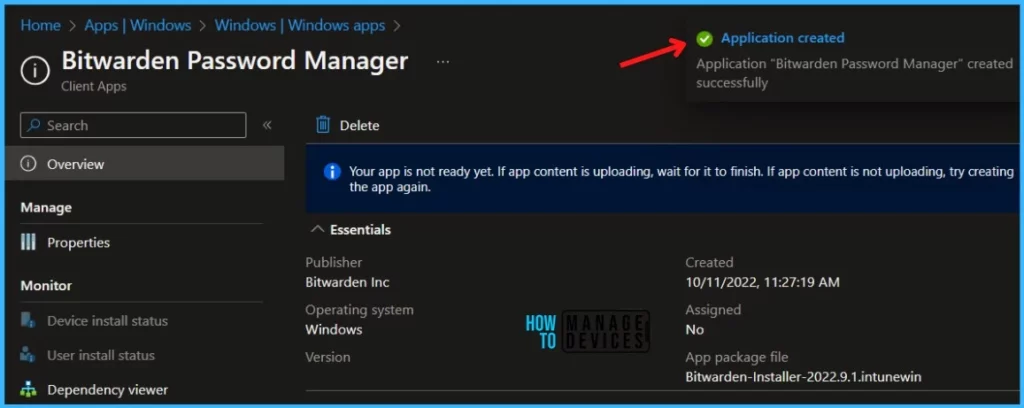
Please wait some time to complete the upload process, and you can check the progress by clicking on the Notification icon.
Once the intune package is uploaded and finished, you will get the status “Upload finished.”
On the client machine, In the Company Portal, You can click on the apps to track the details and check the progress. Here you can see the Bitwarden Password Manager application is installed successfully.
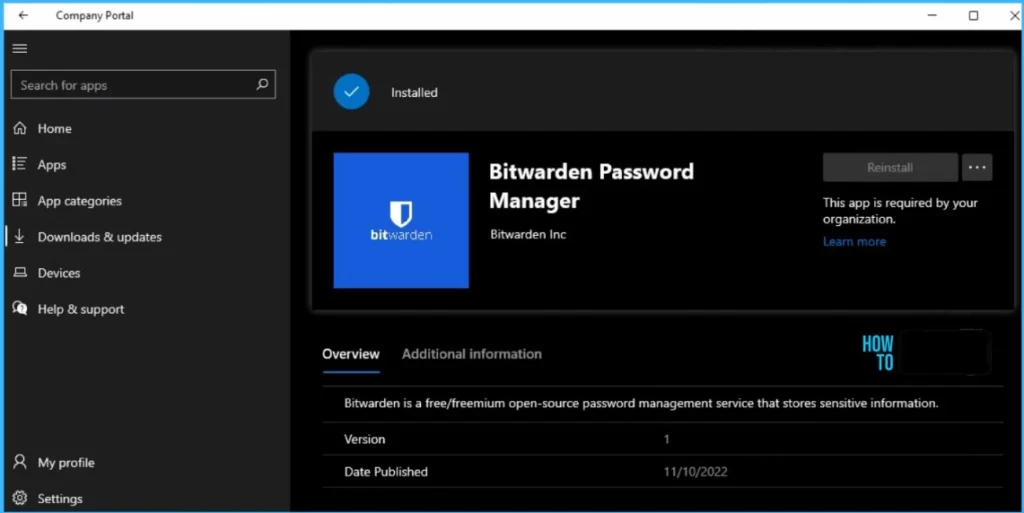
You can track the details logged at IntuneManagementExtension.log located C:\ProgramData\Microsoft\IntuneManagementExtension\Log.
Here are the highlighted parts from the logs that help you track the application activity in client devices. You can get through an excellent article on Intune Win32 App Issues Troubleshooting for more details.
Troubleshooting Win32 App References
For troubleshooting Intune client-side events, you can refer to three logs –
- IntuneManagementExtension.log: Tracks the Intune Management extension component events.
- AgentExecuter: Track any PowerShell execution events.
- ClientHealth.log: Track client-health related events.
Let’s learn Intune Win32 App Troubleshooting Client-Side Process Flow. You can look at the Level 3 deep dive troubleshooting Intune Management Extension (IME) Level 3 Troubleshooting Guide.
